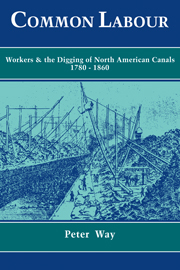Book contents
- Frontmatter
- Contents
- List of tables
- Acknowledgements
- Chronology of construction for main canals
- Abbreviations
- Map: Main canals of the North American Canal Era, 1780–1860
- Introduction
- 1 Early canals, 1780–1812
- 2 “As low as labor and capital can afford”: the contracting system, 1817–1840
- 3 “Human labor, physical and intelligent”
- 4 Payment “fit for labouring people”
- 5 The greatest quantity of labour
- 6 “Canawlers and citizens”
- 7 “Guerilla war”: labour conflict in the 1830s
- 8 “This new order of things”: the 1840s–1850s
- Conclusion
- Appendix 1 Tables 1–16
- Appendix 2 Tables 17–18
- Index
5 - The greatest quantity of labour
Published online by Cambridge University Press: 03 November 2009
- Frontmatter
- Contents
- List of tables
- Acknowledgements
- Chronology of construction for main canals
- Abbreviations
- Map: Main canals of the North American Canal Era, 1780–1860
- Introduction
- 1 Early canals, 1780–1812
- 2 “As low as labor and capital can afford”: the contracting system, 1817–1840
- 3 “Human labor, physical and intelligent”
- 4 Payment “fit for labouring people”
- 5 The greatest quantity of labour
- 6 “Canawlers and citizens”
- 7 “Guerilla war”: labour conflict in the 1830s
- 8 “This new order of things”: the 1840s–1850s
- Conclusion
- Appendix 1 Tables 1–16
- Appendix 2 Tables 17–18
- Index
Summary
When I came to this wonderful rampire [sic], it filled me with the greatest surprise,
To see such a great undertaking, on the like I never opened my eye.
To see a full thousand brave fellows at work among mountains so tall,
To dig through the vallies so level, through rocks for to cut a canal.
“The walk along the embankments is not only highly interesting, but exciting,” wrote a correspondent for the Detroit Advertiser while visiting the St. Mary's Canal at Sault Ste. Marie, Michigan, in 1854.
The frequent processions of barrowmen toiling their slow and weary way up the narrow plank to the sides of the cut – the high platforms erected for the cars used in moving the heavy masses of rock – the horse-drills keeping up their continual buzz as the poor, jaded animals tread to the ceaseless music, and the heated steel descends into the almost impenetrable rock – the noise of the blast which is so loud and frequent as to make one think he is going through the uproarious salute of a grand military reception, or that the 4th of July is perpetuating itself – the stampede among the men as word is passed that a fuse is fired – the scattering of the rock which follows the explosion, sometime shooting innumerable masses of all sizes into the heavens, giving you no bad idea of Ætna and Vesuvius – the voices of the overseers and the louder utterings of the cataract, which all this scene of animation is preparing to overcome for the uses of man.
- Type
- Chapter
- Information
- Common LabourWorkers and the Digging of North American Canals 1780–1860, pp. 131 - 162Publisher: Cambridge University PressPrint publication year: 1993



